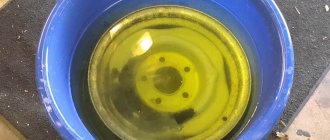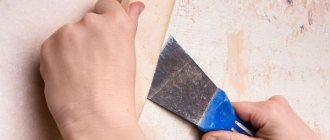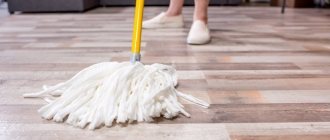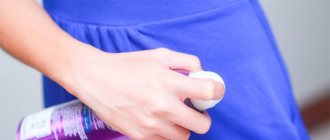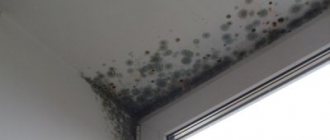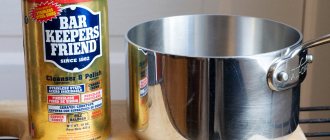During use, scuffs and scratches may appear on the tiles. Sometimes they are not noticeable at all and can only be seen when cleaning surfaces. However, various, even minor defects always cause inconvenience. The best option to restore the aesthetics of the coating is to replace the area of the damaged tile with a new one. However, this is not always possible, since not every person keeps a supply of new coating. To remove scuffs and scratches from tiles, you can resort to some effective methods.
How to remove traces of aluminum from tiles?
Aluminum
Stripes on ceramic
tiles
can be removed and are not that difficult to do.
You need to pour baking soda onto a soft cloth and rub the tile
. You can also moisten this cloth with sunflower oil. It's simple.
Interesting materials:
How to update the Adobe Flash Player plugin in Opera? How to update Lenovo Tab 2 tablet? How to update the plastic in a car interior? How to update Play Market on a tablet? How to update Play Market on an old tablet? How to update software via iTunes? How to update the software on your watch? How to update software on Huawei? How to update software on Honor? How to update software on Macbook Air?
Polishing porcelain tiles on the floor
To restore the original shine of a floor surface covered with glazed or glossy porcelain tiles, cleaning with cleaning products alone is not enough. When walking on the floor, through tiny grains of sand and other hard debris, many tiny scratches are formed on the decorative surface, into which dust and other contaminants accumulate. As a result, the porcelain tile flooring becomes dull, and regular washing and cleaning are ineffective. In this case, the problem is solved by polishing porcelain stoneware yourself or by hiring professionals who will return the flooring to its former shine using specialized equipment.
Polishing tools and materials
If we are talking about the restoration of large floors lined with artificial stone, you cannot do without professional polishing tools. This type of equipment includes electric drive floor polishers, which are characterized by high productivity. But a professional tool for polishing porcelain stoneware floors costs a lot, so purchasing it for private use is not rational. If you need to polish a small ceramic surface at home, it is better and cheaper to use a tool that matches the working volume.
What do homeowners use if they need to polish glossy porcelain tiles, for example? There are two ways to solve the problem. The first is applicable if the area of the polished surface is not at all large. Then the issue is resolved by using hand tools and special polishing agents produced by various manufacturers.
When you need to restore the appearance of a porcelain stoneware coating on a surface with an area of 4-5 m2 or more, it is better to use an affordable power tool, which is also available in almost every home - an angle grinder, better known as an angle grinder. There are many attachments available for this versatile tool, including those for polishing surfaces made of various materials. For polishing porcelain stoneware and smooth natural stone surfaces, felt discs are used that are placed directly on the working axis of the tool. Another option is a replaceable felt attachment, attached using the Velcro principle to a universal disk mount, which, in turn, is fixed on the rotating axis of the angle grinder.
In addition to the necessary tools, to fully polish a porcelain stoneware surface, you will need special compounds designed for these purposes. For example, when polishing glossy porcelain stoneware, various products based on liquid wax are used. After treatment with this composition, not only the former attractiveness and shine of the ceramic floor cladding is restored, but also the anti-slip properties of the smooth surface are imparted. In rooms where there is contact with water or simply high humidity, it is advisable to use a porcelain tile floor polishing paste containing water-repellent silicone.
Porcelain stoneware floor panels: layout options and manufacturers
When purchasing a polishing paste for processing porcelain tile flooring, ask your consultants for the intended purpose of the product - not all compositions are universal and suitable for all types of porcelain tiles.
Polishing technology
It is clear that there is a difference between using a diamond polishing sponge to polish porcelain tiles by hand and using a professional polishing pad. But the sequence of working stages when using tools and mechanisms of varying complexity and productivity does not change significantly. Polishing a porcelain stoneware floor works like this.
- The surface is thoroughly cleaned of dirt, dust, and solid particles. For this purpose, dry and wet floor cleaning is used.
- A porcelain tile polishing agent is applied to the cladding in a thin layer, evenly and without gaps. Depending on the technology used (when it comes to professional restoration of the coating), two layers of polishing agent may be applied.
- After the specialized paste has dried, the surface is mechanically polished using felt nozzles.
As a result of such restorative treatment of porcelain stoneware floor cladding, the coating returns to its original appearance, matte or glossy shine (depending on the type of porcelain stoneware used in the finishing). In addition to visual appeal, polishing provides protection of the decorative surface from mechanical and chemical damage, exposure to excess moisture, thereby extending the service life of the facing material.
Sander
This is the most difficult way to remove scratches. It is suitable if other methods do not work. You will need a felt circle. Turn on the sander at medium speed. Continue polishing the surface until the scratches are completely gone. Be extremely careful with equipment!
Getting rid of scratches on tiles: different methods
Even the highest quality ceramic tiles can lose their appearance over time. It develops cracks, abrasions, scratches and other defects. At first, it is practically invisible, but over time, minor damage results in visible imperfections that spoil the aesthetics of the room. In such cases, damaged ceramic tiles can always be replaced with new ones. But what to do if there are no more stocks left, and you can’t buy the same one in the store anymore? If you don’t want to carry out major repairs, you can restore the tiles. There are several simple ways, which we will discuss further. Even a beginner in the repair industry can cope with them.
How to close holes in bathroom tiles?
You can fill holes in the tiles with epoxy resin. To do this, buy dyes that are suitable for the resin. First, clean the holes from dirt. The hardener is poured into the resin, mixed thoroughly, then the dye is combined with the resin so that the color of the resin and the tile matches.
Interesting materials:
What is better to put on the floor at the dacha? What is better to put on the floor on the loggia? What is better to lay laminate or linoleum on the floor? What is better to lay on the floor? What is better to lay on a warm floor? Is it better to take creatine or protein? Which is better, squats or deadlifts? What is better, a down jacket with down or synthetic padding? What is better solvent or acetone? Which is better Deadlift or Romanian deadlift?
Basic processing tips
If you want your tiles to shine, it is recommended that you clean them correctly. Experienced housewives and professional cleaning service employees have developed step-by-step instructions that will allow you to achieve the desired effect:
- Get rid of large amounts of dirt and debris. For example, if the bathroom or kitchen has been renovated, the premises have just been handed over to the developer, or the premises have not been thoroughly cleaned for a long time.
- Remove fine dust. To do this, use a dry cloth or mini vacuum cleaner. Dust brushes are not recommended - limescale deposits, as well as grease, are dangerous for this tool.
- Wash off dirt. For difficult stains, such as stubborn rust or old greasy deposits, select products individually.
- After the stains have been dealt with, rub the tiles with polish, soap or other composition until shiny.
Methods for restoring porcelain floor tiles
Types of porcelain tiles for floors and their characteristics
Regular proper care of ceramic floor coverings and the use of protective compounds significantly prolong the wear of the floor covering. But long-term use still inevitably leads to the need to restore the surface. The main method of restoring a porcelain stoneware floor surface is to deep grind the facing material. In small areas, it is possible to polish porcelain tiles with your own hands, although preference is given to the services of professionals who, using specialized equipment, can give the floor cladding its original appearance.
Grinding
A feature of many types of porcelain stoneware is the deep structure of the tile substance. This makes it possible to sand the top layer of the coating (up to 0.5 mm) without changing the decorative texture. Complete restoration of porcelain stoneware, carried out by professional teams, consists of several successive stages.
- Repairing large damage, removing grout between tiles and filling the joints with fresh mortar.
- Mechanical leveling of the floor surface with removal of significant unevenness (coarse diamond abrasive is used).
- Fine grinding of porcelain stoneware coating, with each subsequent pass the abrasive grain size decreases.
- Polishing the surface using a fine-grained abrasive paste, during which minor scratches and abrasions are removed, and the original color and shine of the cladding are restored.
- Treatment of porcelain tiles with hydrophobic compounds that repel water and increase the resistance of the material to various organic pollutants and chemically active substances.
Professional polishing of porcelain tiles has different prices, depending on the region and the range of additional services. The cost of work for one of the companies is shown in the table.
| № | Name of service | Cost in USD per m2 |
| 1 | Cleaning and sanding porcelain tile flooring | From 10 |
| 2 | Deep processing of porcelain stoneware coating | From 20 |
| 3 | Treatment with hydrophobic impregnation | From 15 |
| 4 | Cleaning the porcelain stoneware coating from heavy dirt followed by polishing | From 15 |
Restoration of scratches and chips
To seal large damage on the surface of porcelain stoneware, those that cannot be corrected by grinding, the sealing method is used. The basis of the material for such restoration of porcelain tiles is usually one of the types of polyester glue. By adding various dyes to the glue, a mastic is prepared that can not only firmly seal a pothole or large crack in an artificial stone, but also reflect its texture as accurately as possible so that the seal in the coating is minimally noticeable.
At home, it is possible to restore large damages with epoxy glue, which is almost as strong as artificial granite. However, it can be difficult to choose the right color and decorative parameters on your own.
Preventive measures
To make it easier to clean bathroom tiles until they shine, you need to follow preventive measures. The main enemy of ceramics is condensation. It accumulates in the bathroom after using the room. It is necessary to ensure good ventilation in the bathroom and heating in winter. It is recommended to wipe the tiles after each bath and shower. In addition, try to avoid other contaminants left by hygiene products and powder.
Ceramic tiles in the bathroom must be washed with detergents at least 2-3 times a month. To maintain the shine of a glossy finish, it is recommended to use home remedies or special impregnations and varnishes.
In order not to spend a lot of time and effort on caring for tiles, it is better to take simple preventive measures.
Features of glass-ceramic plates
One of the newest developments in the field of household kitchen appliances are electric stoves with a smooth glass surface and with burners marked on it. Glass-ceramic hobs are more expensive than conventional electric hobs, but their high cost is offset by lower energy costs during their operation. Savings are achieved due to the increased thermal conductivity of glass ceramics, thanks to which the burner heats up instantly, and the generated heat is quickly transferred to the pan.
Means and rules for daily care of porcelain tiles
It is not difficult to clean porcelain tile flooring from common contaminants. It is enough to vacuum the surface, getting rid of solid particles, and then do a wet cleaning with plain water or a weak soap solution. It is not advisable to wash the floor without first removing solid debris, especially when facing with glossy porcelain tiles - fine sand present in the dust can make small scratches on the surface of the tiles, which over time will lead to the need to polish the porcelain tiles. Matte artificial stone is the least susceptible to mechanical damage and the influence of chemically active substances, therefore, with such cladding, the choice of means and methods for cleaning the surface is not limited.
Problems often arise with cleaning structured porcelain tiles, which have a relief decorative surface, due to which some substances eat into the tiles, and it can be difficult to wash off the resulting stain. Specialized cleaning products designed to remove dirt on porcelain tiles will help here. The most famous and reputable manufacturer of such products is the German company Glutoklin (Pufas), which offers a line of substances for cleaning porcelain tile cladding from various contaminants. Here are the types of dirt on the tile surface that this brand has special products to combat:
- wax, fat, oil stains;
- adhered remains of cement and tile grout;
- stains from organic dyes;
- streaks of rust.
In addition, Glutoklin offers a variety of cleaning and care products for porcelain stoneware, from detergents for daily cleaning to all kinds of protective impregnations for artificial stone.
Nothing prevents you from caring for porcelain tiles with products from other manufacturers, but it is important to pay attention that they are intended specifically for porcelain tiles.
